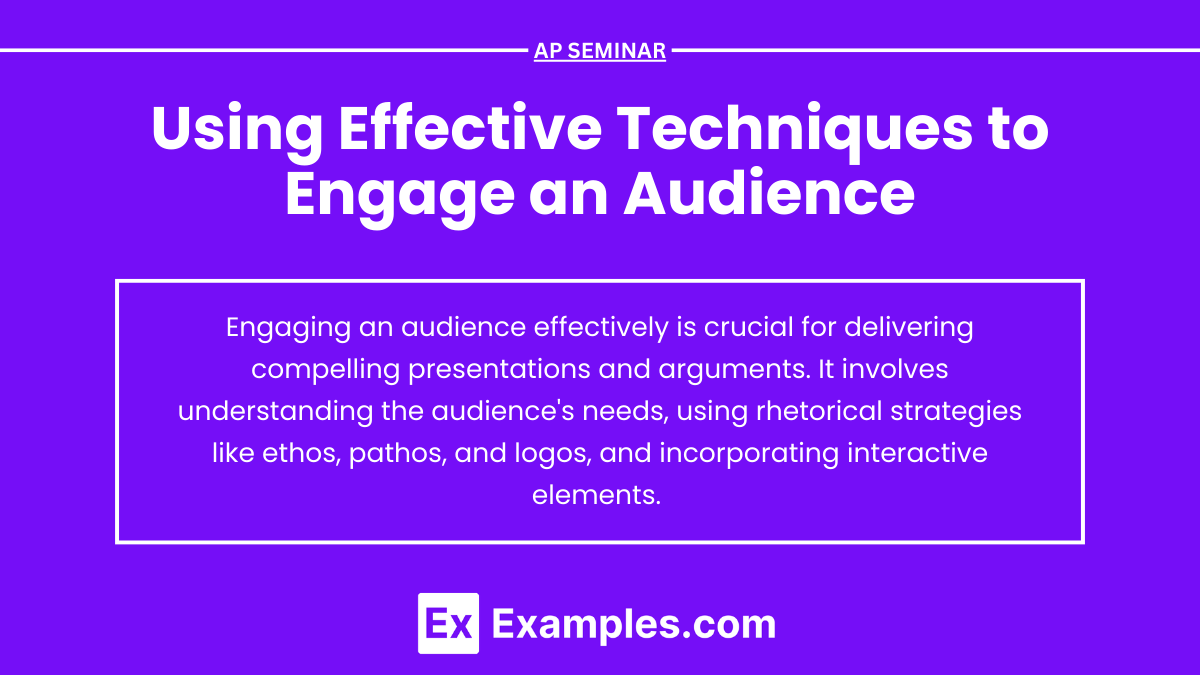Engaging an audience effectively is crucial for delivering compelling presentations and arguments. It involves understanding the audience’s needs, using rhetorical strategies like ethos, pathos, and logos, and incorporating interactive elements. By combining clear structure, visual aids, and engaging delivery techniques such as body language and vocal variety, speakers can capture and maintain attention. This approach not only enhances communication but also ensures that key messages resonate, making the audience more receptive and invested in the topic.
Learning Objectives
In the AP Seminar exam, focus on mastering the techniques for engaging an audience, including understanding audience needs, structuring content clearly, and using rhetorical strategies like ethos, pathos, and logos. Develop skills in effective presentation, utilizing visual aids, body language, and vocal variety. Learn to foster interaction through questions and feedback, and prepare thoroughly to anticipate challenges. Enhance clarity and impact through precise language and storytelling, concluding with strong summaries and calls to action. These skills will ensure compelling and persuasive presentations.
Using Effective Techniques to Engage an Audience
Engaging an audience effectively is key to delivering a compelling presentation or argument. This involves a blend of content delivery, rhetorical strategies, and presentation skills. Here are some essential techniques:
1. Understanding Your Audience
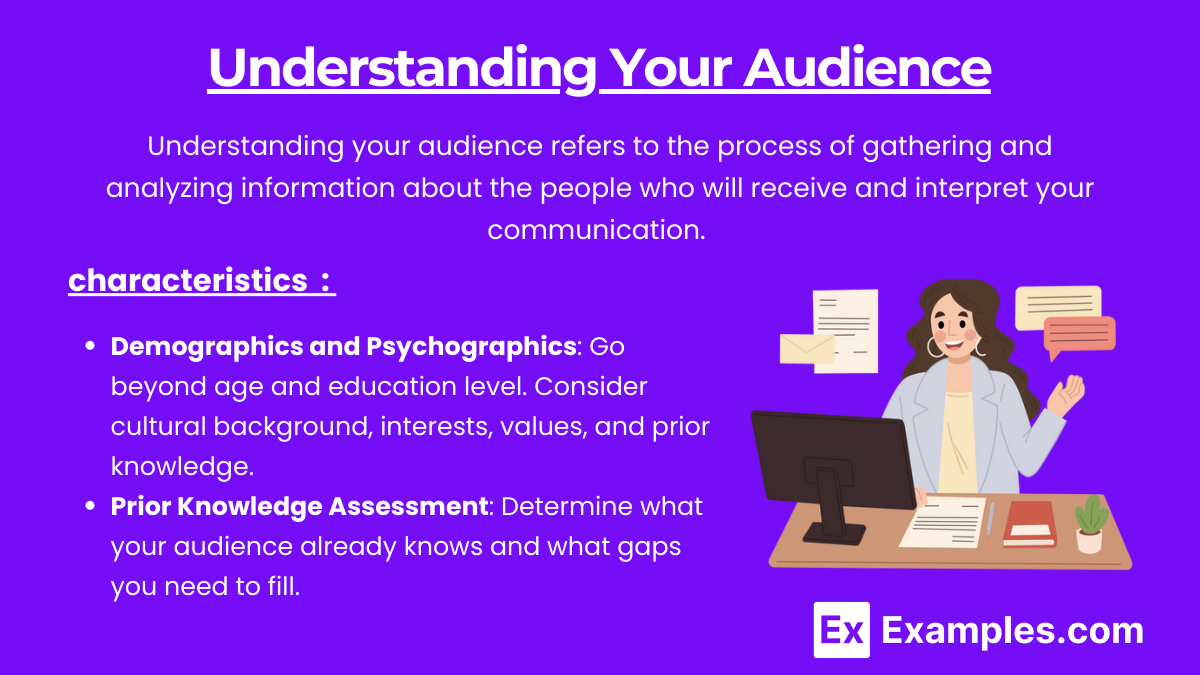
Understanding your audience refers to the process of gathering and analyzing information about the people who will receive and interpret your communication. This understanding involves identifying key characteristics such as demographics, psychographics, interests, values, cultural background, and prior knowledge.
- Demographics and Psychographics: Go beyond age and education level. Consider cultural background, interests, values, and prior knowledge. Tailoring your content to resonate with these aspects can greatly enhance engagement.
- Prior Knowledge Assessment: Determine what your audience already knows and what gaps you need to fill. This helps in adjusting the complexity and depth of your presentation.
2. Content Organization and Clarity
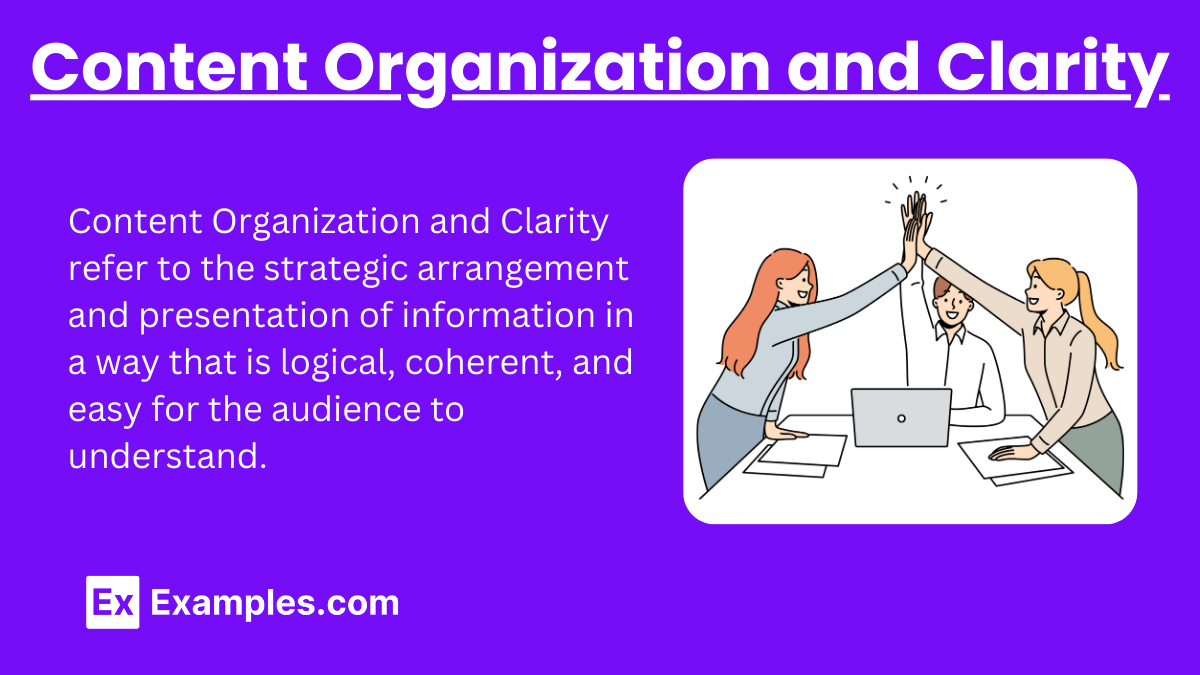
Content Organization and Clarity refer to the strategic arrangement and presentation of information in a way that is logical, coherent, and easy for the audience to understand. This involves structuring content in a clear, logical sequence, ensuring that ideas flow smoothly from one point to the next, and presenting information in a manner that avoids confusion.
- Outlining and Planning: Before diving into creating your presentation, outline the main points. This helps in ensuring all critical aspects of your topic are covered and presented logically.
- Transition Statements: Use clear transitions between sections to help the audience follow along. Phrases like “This leads us to the next point,” or “Building on this idea,” can maintain a smooth flow.
3. Rhetorical Strategies

Rhetorical strategies are techniques used by speakers and writers to persuade, inform, or engage an audience. These strategies leverage various appeals—such as ethos, pathos, and logos—to effectively communicate ideas and achieve the speaker’s or writer’s purpose.
- Ethos (Credibility): Build ethos by sharing your credentials, experience, or connections to the topic. Mention any research you’ve conducted or relevant work you’ve done.
- Pathos (Emotional Appeal): Be careful to balance emotion with logic. Use emotional appeals ethically and in moderation, ensuring they complement rather than overshadow your main points.
- Logos (Logical Appeal): Strengthen your arguments with well-organized evidence. Use statistics, expert testimonials, and case studies to support your claims.
4. Engaging Presentation Techniques
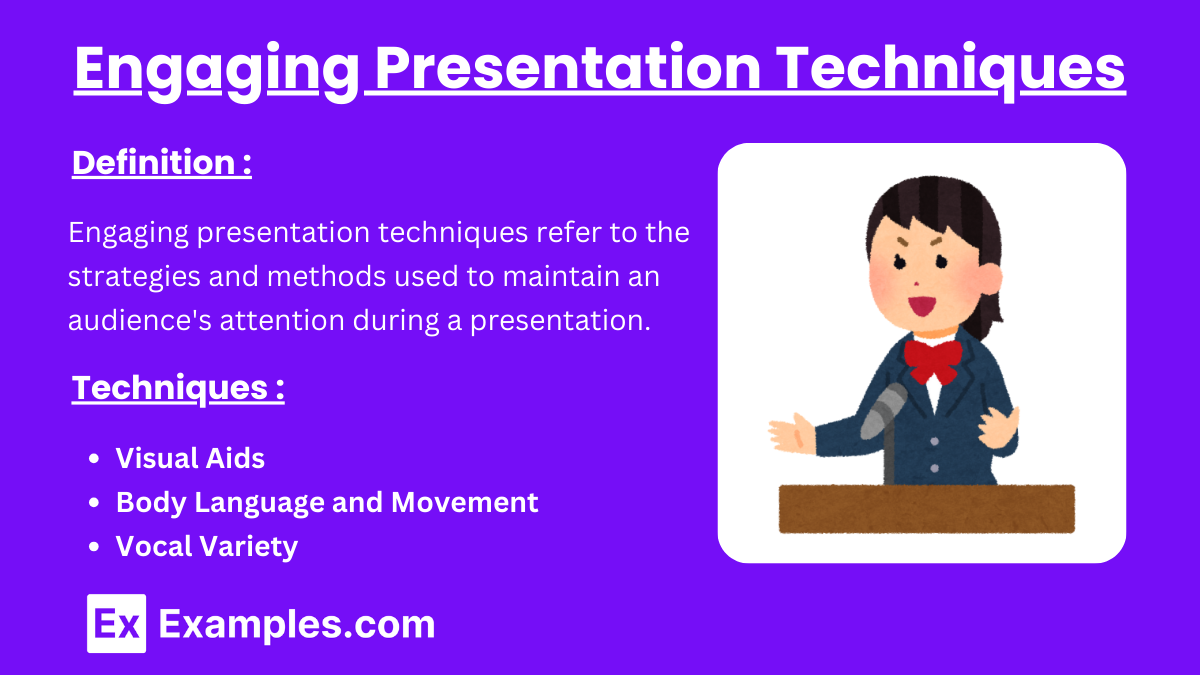
Engaging presentation techniques refer to the strategies and methods used to captivate and maintain an audience’s attention during a presentation. These techniques enhance the delivery of content, making it more dynamic, interactive, and memorable. They encompass a range of practices, including the use of visual aids, effective body language, and vocal variety, all aimed at creating a more engaging and impactful presentation experience. Key Components are below :
- Visual Aids: Ensure visual aids are not overly text-heavy. Use bullet points, short phrases, and visuals that are directly related to your spoken content.
- Body Language and Movement: Utilize the space available to you. Moving deliberately across the stage can emphasize different points and keep the audience visually engaged.
- Vocal Variety: Avoid monotone delivery. Practice varying your pitch and volume to highlight key information and maintain audience interest.
5. Interaction and Engagement
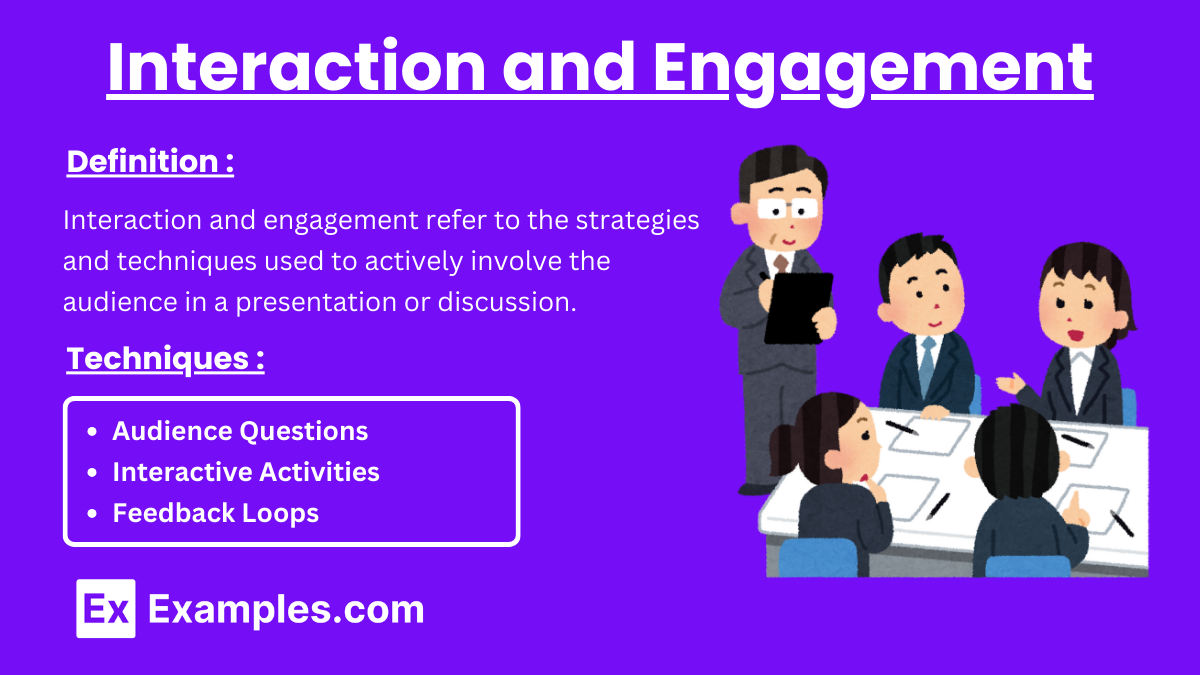
Interaction and engagement refer to the strategies and techniques used to actively involve the audience in a presentation or discussion. These methods are designed to foster a two-way exchange between the presenter and the audience, making the session more dynamic, responsive, and memorable.
- Audience Questions: Pose rhetorical questions or direct questions to the audience. This can be an excellent way to re-engage a drifting audience.
- Interactive Activities: Depending on the setting, consider interactive elements like live polling (using tools like Mentimeter or Kahoot), or quick, interactive exercises that relate to your topic.
- Feedback Loops: Include opportunities for the audience to give feedback, either verbally or through interactive tools. This can make the session more dynamic and responsive.
6. Practice and Preparation
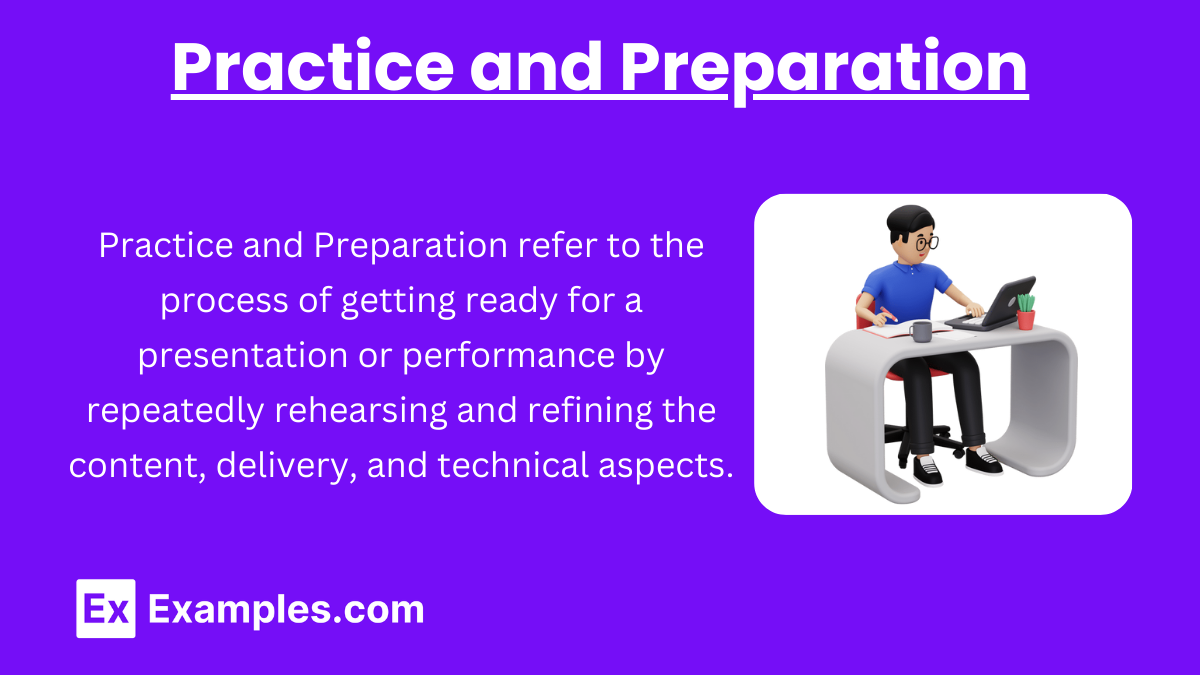
Practice and Preparation refer to the process of getting ready for a presentation or performance by repeatedly rehearsing and refining the content, delivery, and technical aspects. This stage is crucial for ensuring that the presenter is confident, clear, and capable of engaging the audience effectively.
- Detailed Rehearsal: Rehearse your presentation in front of a mirror or record it to review your performance. Pay attention to your body language, tone, and pacing.
- Mock Presentations: Practice with a small audience to get constructive feedback. This can help you fine-tune your delivery and content.
- Technical Preparations: Test all equipment beforehand. Have backups of your presentation materials, and be familiar with the technology you’ll be using.
7. Effective Use of Language
- Active Voice: Use active voice to make your sentences clear and direct. This can make your points stronger and more engaging.
- Simplification: Break down complex ideas into simpler concepts. Use analogies and metaphors to explain intricate points in a relatable way.
- Power Words: Use strong, descriptive language to paint a vivid picture. Words like “transformative,” “compelling,” and “unprecedented” can evoke stronger reactions.
8. Conclusion and Call to Action
- Memorable Conclusion: End with a strong statement or quote that encapsulates your message. A memorable closing can leave a lasting impression.
- Clear Call to Action: Make your call to action specific and actionable. Whether it’s to visit a website, consider a new perspective, or engage in further research, clarity is key.
- Closing Thank You and Q&A: End by thanking your audience and inviting questions. This shows appreciation and opens the floor for further engagement.

